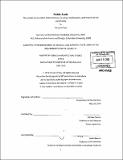Public scale : the arcade as an urban phenomenon, its urban implications, and how it can be used today
Author(s)
Chou, Ching Yi, S.M. Massachusetts Institute of Technology
DownloadFull printable version (39.04Mb)
Alternative title
Arcade as an urban phenomenon, its urban implications, and how it can be used today
Other Contributors
Massachusetts Institute of Technology. Dept. of Architecture.
Advisor
Michael Dennis.
Terms of use
Metadata
Show full item recordAbstract
There is an urban phenomenon called an arcade. I will study it and show how it can be used today. I will investigate its autonomy in forming a public space, the external society, economy, climate, program, and geography, being auxiliary to its core essence. After representing the history and morphology of the square, a type of arcade, I will demonstrate how it can be used to enhance the city's public good and the arcade's value, through the examples of two squares in Taipei. Region after region of rooms breaks the boundary between the human scale and the vehicle scale of traffic flow and the boundary between traffic flow and other activities. The contemporary public program turns the public dimension outside-in successfully, more as a container than a form of separation based on the logic of differentiating a primary room from secondary ones using arcades and squares. An arcade, composed of pillars and arches, was one of the primary elements to enclose public space. The arcade acts as a path and secondary space to the central space. It is gradually disappearing in contemporary architecture. Many of research have studied all significant arcades through out the history but none of them investigate in their current uses. I will demonstrate arcade's current uses through two squares designs in Taipei. The fragmented urban fabrics can be mended with arcades in the current rapid urban sprawl. Why designing based on a square and inserting arcades can serve an answer to the disappearance of arcades and their relation with public space. The center of Taipei City has shifted from the west to the east since 1980. The land value has grown by a factor of three, but the city parcels in western Taipei are still very tiny. The government promotes combining the parcels into larger ones and the public plan for the western part of Taipei encourages unification, considered as a whole. This will mean a bigger, unifying street elevation, and internally fragmented underutilized plots relevant to big public spaces will be opened up. Continuous arcades and a self-explanatory public space in modern times function as a remedy for the problems of modern architecture in Taipei, a city that lacks coherence. Arcades also may be able to remedy the discontinuity of the urban fabric on the west side in the old part of Taipei that has occurred due to the rapid urban sprawl, creating legible public spaces and reorganizing the chaotic fabric. The two square designs approach public scale on two levels: one monumentally shapes the open public space. The second, a town hall loggia, infills the site as interior public rooms. As the idea of an interior arcade extends the transparent facade of the town hall, which intimately interacts with street and facade in the neighborhood.
Description
Thesis (S.M.)--Massachusetts Institute of Technology, Dept. of Architecture, 2010. Page 139 blank. Cataloged from PDF version of thesis. Includes bibliographical references (p. 137-138).
Date issued
2010Department
Massachusetts Institute of Technology. Department of ArchitecturePublisher
Massachusetts Institute of Technology
Keywords
Architecture.